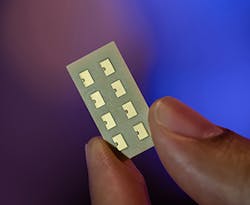The first specimens of hardware based on 5G technology are almost here. Samsung Electronics says that it has built miniaturized antennas based on its understanding of the technology, while Mediatek has around 100 engineers working on 5G versions of its power-sipping silicon. But most chipmakers have stopped short of actual products.
That changed Monday when Qualcomm announced its first chip for connecting smartphones, routers, sensors, and other gadgets to 5G networks. It went forward with announcing the modem in spite of the fact that an industry standard is still roughly four years away.
The chipmaker said that the Snapdragon X50 modem will deliver download speeds up to 5 gigabits per second, making it around 20 times faster than the latest fourth-generation technology. That speed is necessary, the company said, to create far more versatile networks.
The San Diego-based company said that samples will be available in the second half of 2017. The first products using the modem will appear in 2018, it said.
The details of the Qualcomm chip, which were announced Monday at a technology conference in Hong Kong, include several features that are almost certain to be added to a 5G standard. The modem will operate over millimeter wave spectrum in the 28 GHz band, coordinate multiple antennas to lower latency and hasten downloads, and bend antenna beams to improve reliability.
But the final definition of the standard is still not finished and no one is certain how 5G will work exactly. Qualcomm might eventually have to redesign its modems to conform to new versions of the standard. Most wireless carriers don't plan to offer 5G networks before 2020.
But not everyone wants to wait another four years for the final standard. Verizon plans to launch preliminary 5G networks in 2017, and wireless carriers in South Korea are aiming to provide new services during the Winter Olympics in 2018.
5G is expected to provide massive improvements over existing technology. People using smartphones on 5G networks will browse the internet, download files, and stream videos faster and with fewer interruptions. 5G chips might also be used to connect delivery drones, virtual reality headsets, and billions of wireless sensors – all of which need networks that respond quickly and exchange reams of data with the cloud.
As wireless connectivity shifts into almost everything, Qualcomm, the largest maker of modem chips for smartphones, is facing stiff competition from Mediatek and Samsung. Another contender is Intel, which views wireless chips as a cornerstone of its business, linking phones and sensors to servers equipped with its computer chips. Intel recently polished its modem-making reputation, selling chips to Apple for some models of the iPhone 7.
Qualcomm is trying to preserve its edge by releasing new technology before competitors. In February, it revealed the X16 modem chip that supports downloads up to 1 gigabit per second. That contrasts with the 225-megabit download speeds of the latest 4G technology, also known as LTE Advanced.
On Tuesday, the chipmaker said that Australia’s Telstra would be the first wireless carrier to provide gigabit wireless networks, and that Netgear would build the first router equipped with the X16 modem. The Wi-Fi router will connect to Telstra's network via cellular technology instead of fiber optic cable.


